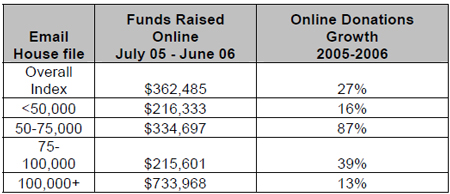As more and more organizations turn to the Internet to enhance and expand their fundraising, advocacy and communications work, a number of key questions have arisen, including:
- How does our online program compare to other programs?
- What are reasonable goals for list growth, response rates, churn rates, etc?
- How can we measure the success of our online work?
Until very recently, little data existed with which to answer these questions. However, in the past year, several studies have aimed to establish the benchmarks needed to evaluate the performance of nonprofits’ online communications, advocacy, fundraising, and email messaging programs.
We recently reviewed these studies: the eNonprofit Benchmarks Study, the Online Marketing (eCRM) Nonprofit Benchmark Index ™ Study, and the donorCentrics™ Internet Giving Benchmarking Analysis, and we have provided a brief summary below of the main findings on which all three studies agree. However, this summary should not be considered a substitute for reading the full reports listed in the table below.
SHARED FINDINGS
The three recent benchmarks studies capture online program metrics from a variety of nonprofits that focus on a multitude of issue areas. Though the data differs somewhat among the studies, one point is perfectly clear: the Internet is the place for nonprofits to invest!
1. Online Giving Is On The Rise
All three studies found that the amount of money raised online per organization is rapidly increasing. Though the statistics vary fairly widely, the studies reflect the general trend of growth in nonprofit online fundraising programs.
- The Online Marketing (eCRM) Nonprofit Benchmark Index™ reports a growth rate of 27 % in median dollars raised from 2005 to 2006.
- The eNonprofit Benchmarks Study reports a 40 % growth in average amount raised from the year 2003-2004 to the year 2004-2005.
- The donorCentrics Analysis reports that the median cumulative growth in online donors amongst its study participants has been 101% over the past three years.
2. Rapid Response Pays
Both the eNonprofit Benchmarks Study and the donorCentrics Analysis note significant spikes in online donations due to giving after the Asian tsunami and Hurricane Katrina. All three studies emphasize the importance of nonprofits’ quick response to a natural disaster or other breaking news.
3. Email Lists Are Growing
The eNonprofit Benchmarks Study and the eCRM Nonprofit Benchmarks Index™ both report growth in email list sizes. The former reports an average growth of 73% across the 15 study partners from September 2004 to September of 2005. The latter reports a median growth rate of 47% from July 2005 to June 2006. In addition, the Index Study reports that organizations with smaller lists (under 50,000) grew twice as fast as those with larger lists.
4. Bigger Lists = More Money & More Actions
The eNonprofit Benchmarks Study illustrates that email list size is directly proportional to the number of advocacy actions and letters generated (see the table below). Simply put, the bigger the email list, the larger the number of advocacy actions generated.
* Table from eNonprofit Benchmarks Study
Likewise, the eCRM Nonprofit Benchmarks Index™ split funds raised online by email list size to show the difference in amount raised by various file sizes. Although the table below shows a drop in funds raised for the 50,000-75,000 list size range, the trend of larger email lists raising more money holds true.
*Table from the eCRM Nonprofit Benchmark Index ™ Study
5. Fundraising Messaging Metrics Holding Steady
Both the eNonprofit Benchmarks Study and the eCRM Nonprofit Benchmark Index™ calculated open, click through, response, and conversion rates on fundraising messaging from their data. From the table below, we can see that these metrics have stayed consistent over the last two years.
ADDITIONAL INTERESTING FINDINGS
1. Online Donors Versus Offline Donors
The 2006 donorCentrics™ Internet Giving Benchmarking Analysis by DonorDigital and Target Analysis Group reviewed data from 12 nonprofit organizations to compare online giving with offline giving. The key takeaways include:
- Online donors tend to be much younger and to have higher incomes than direct mail donors.
- The distribution of online donors is more evenly spread over age ranges while direct mail donors are heavily concentrated in the 65-and-older age group.
- Online donors tend to join at higher giving levels, give larger gifts, and have higher lifetime giving than offline donors.
*Data in table taken from 2006 donorCentrics™ Internet Giving Benchmarking Analysis
- Only 4% of newly acquired online donors also gave direct mail gifts in their first year on the list, but 46% of them gave direct mail gifts in their renewal year.
- Multiple-channel donors have higher revenue per donor and higher retention rates than single-channel donors.
- Revenue for donors who gave online was 28% higher ($114 compared to $82) than donors who only gave offline.
- Donors acquired online tend to lapse at higher rates than donors acquired by mail. Some of this turnover may be attributed differences in cultivation strategies.
2. Website Traffic and Site Visitor Registration
Convio’s Online Marketing (eCRM) Nonprofit Benchmark Index™ Study looked at website traffic and visitor registration across 16 client websites. The key points the study found include:
- The websites received an average of roughly 26,000 unique visitors per month.
- The groups had a median growth rate of 30 % in unique web visitors in the year studied.
- Groups with e-newsletters and member center registration had a median registration rate of 2.8 % per month.
- Recommendations for improving website sign up rates included consistently providing compelling content and incentives to register, optimizing the registration process, and providing multiple engagement opportunities.







